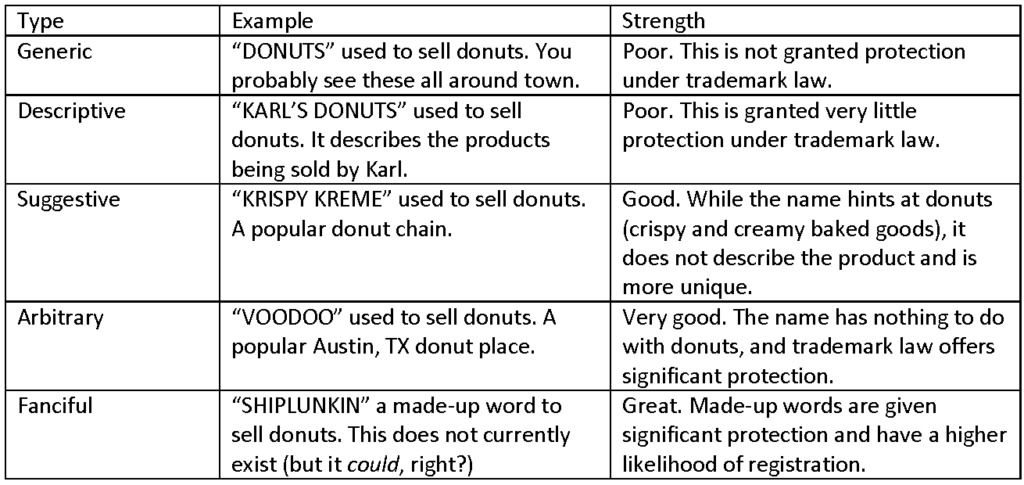BRAND SAFE: A Trademark Guide for Your Agency’s Next Branding Project

Deciding on a brand name, logo, or slogan is not an easy process. It is even harder when you submit your proposal for legal clearance and your lawyer says, “back to the drawing board”. Trust us, we hate saying this as much as you hate hearing it!
We have developed this guide for two reasons. First, whenever you decide on a brand scheme without consulting a lawyer, we hope that you will use these tips to help reduce your risk of infringement. Second, when you do have a lawyer run a clearance check, we hope this guide will prevent a lot of “back to the drawing board” emails and instead turn them into green lights.
TIPS FOR PICKING A MARK
- Creativity is Important
Trademark law is complicated, but there is one key idea to keep in mind – creativity is valued by trademark law. The following scale can be used to determine just how “creative” a mark is in the eyes of the law:

Keep this chart handy whenever you are picking names and logos – it can save you a lot of headache. The point is that “more creativity = more protection”.
- Distinctness is Required
A lot of clients ask us “Can I just spell the mark differently from my competitor?” or “What if I add an extra word so my mark is a little different?” The one question clients should be asking, however, is “Would the average customer confuse my brand for another brand?” This question involves the concept of distinctness, which trademark law requires.
To illustrate this concept of distinctiveness, we are going to use the ever-popular brand, McDonald’s. Imagine the following scenarios, and ask yourself if you would assume THE McDonald’s was responsible for the product or service:
- McDonald’s Tacos
- McDonald’s Grill Set
- McDonald’s N95 Face Masks
- McDonald’s Massage Parlor
Tacos and a grill set? You’d probably assume THE McDonald’s was expanding into some new ventures. N95 masks? Maybe if the masks were yellow or had Ronald on them, but less likely to be from the restaurant. Massage Parlor? Highly doubt you would think that was a business of THE McDonald’s. The lesson here is that if an existing business could potentially expand into the products or services you will be selling, your mark needs to be distinct from theirs in the minds of customers.
Let’s do one more test – ask yourself the same question. If your friend asked you to grab a burger from the following places, would you go to THE McDonald’s?
- McRonald’s Hamburgers
- Donald’s Hamburgers
- McDougal’s Hamburgers
- Don’s Burgers
McRonald’s and Donald’s? You might assume your friend was being funny or that you heard them wrong, and you would go to McDonald’s. McDougal’s and Don’s? Those are pretty clearly local joints. The tip here – just because something is spelled different or sounds a little different from another mark doesn’t mean it’s a good mark to use.
TIPS FOR CLEARANCE
Okay, let’s say you followed the above tips and you feel like you have a solid name or logo picked out. Your next step is to perform some preliminary legal clearance. REMEMBER, these tips are not the extensive, multi-hour legal clearance that your attorney performs while hunched over a desk like a boiled shrimp. These are tips to increase your chance of success and decrease your potential risks so that you can save yourself time and money.
Using the advice in this article, run searches. Search for the exact name, for variations, for sound-alikes, and use the reverse image lookup for logos. Make note of anything similar to your own as well as the products and services. If there are clear conflicts, consider amending your mark.
PRO TIP: Owning a domain name does not give you (or your competitors) the automatic right to use a trademark. These can be taken into consideration, but they are not determinative.
- Social Media
Not everyone has a website, and social media can be a great way to peek around at your competitors’ trademarks. Look at handles, hashtags, podcasts, events, etc. Make note of frequency of activity, scale of the business, and location.
PRO TIP: One-time uses of a mark are not as concerning as continuous uses. Local uses are not as concerning as national uses.
- The Trademark Database
The trademark database is intense and requires an attorney to fully evaluate the impact of the searches run. However, it is a great way to see if someone has already registered or applied for your exact mark. For example, if you want to sell athletic clothes under the name “Gymshark” and type the name into the database, you will quickly see registrations for that exact name in the category of athletic clothes.
PRO TIP: To search for your exact mark, include quotation marks around the phrase.
FINAL WORDS OF ADVICE
We have given you a lot of information in this article, but it is the tip of the iceberg when it comes to a true trademark evaluation and clearance procedure. Therefore, keep these final tips in mind:
- Never give your client a guarantee that a mark is “clear for usage.” Disclaimers should be in your contracts, SOWs, and other communications stating that final legal clearance is your client’s responsibility and that you cannot guarantee a trademark is available.
- Get your lawyers involved in the search and evaluation process, especially once you have picked out a brand or name that you feel has a good chance of success. We will work with you to evaluate whether or not to move forward with a brand scheme.
- Keep timelines in mind. The trademark office is very slow, and application processing can take over a year. It’s best to get applications and clearance searches run early, especially if your client is investing a significant amount of resources in a re-brand or a new brand. You want to have the greatest chance of success possible!
Comments are closed